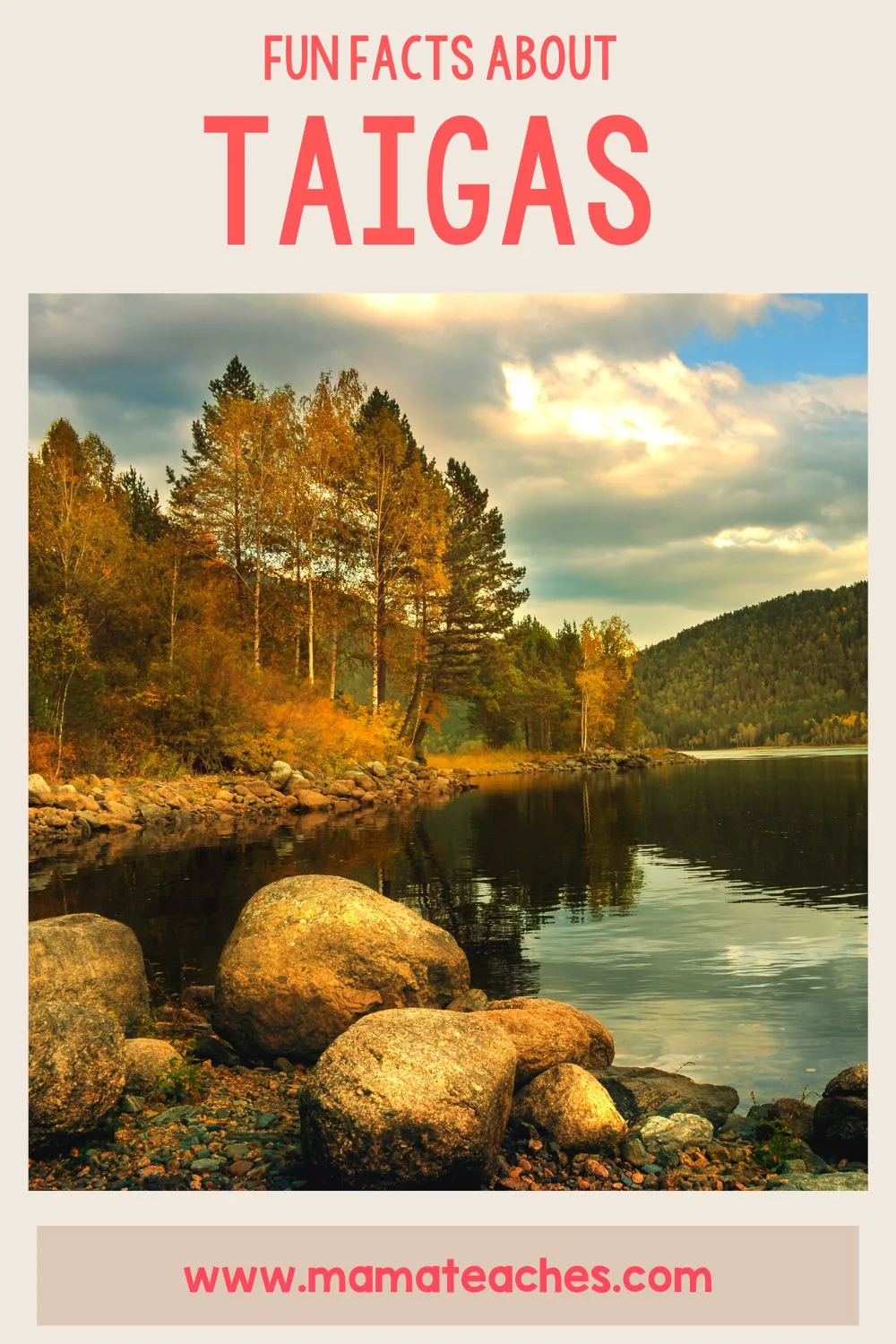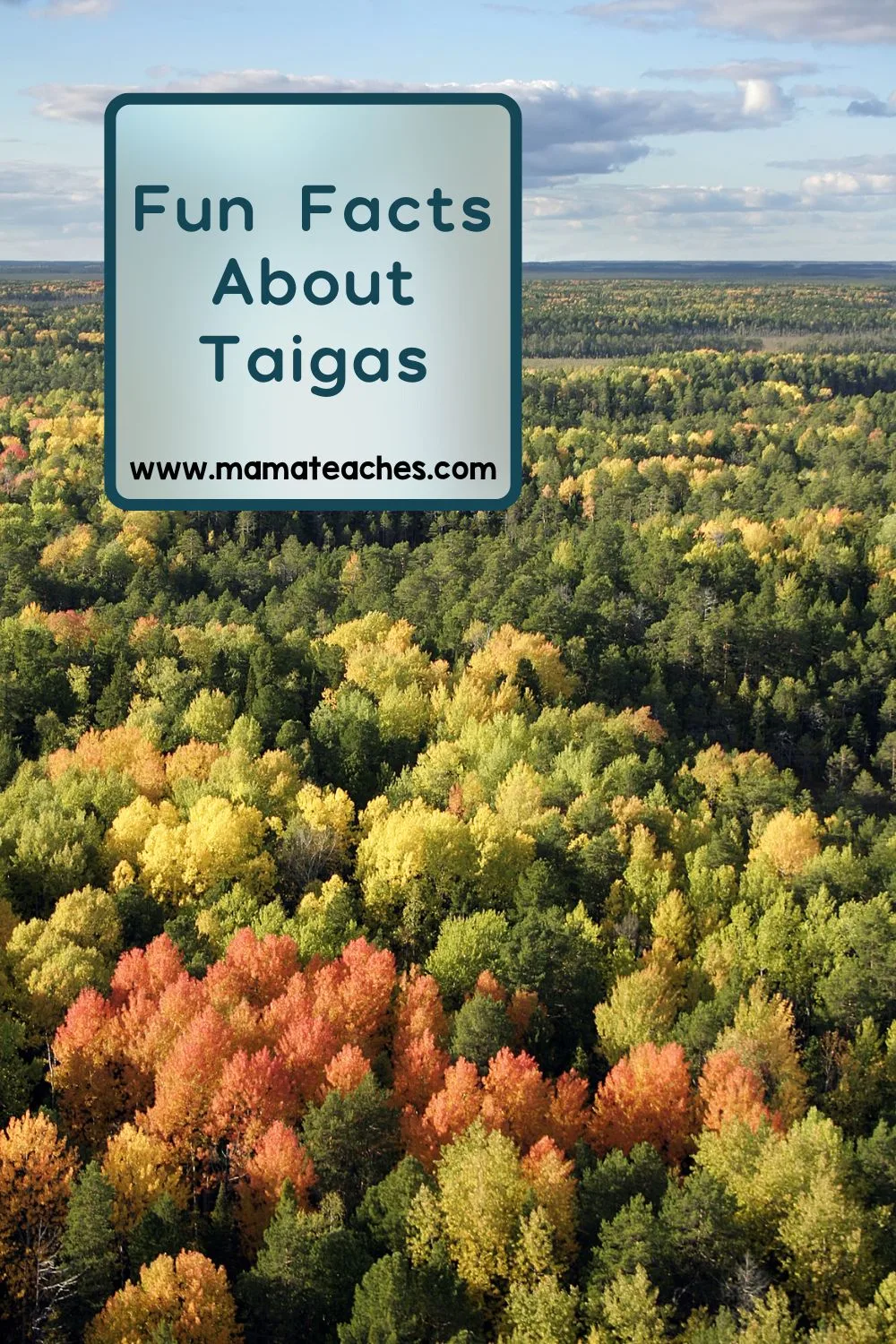What is the largest biome? The taiga! Learn all about the fascinating snow forest with these fun facts about taigas.

Basic Facts About the Taiga Biome
Taigas are one of the major biomes. They are also called snow forests or boreal forests.
Taigas are covered with trees like pine, spruce, and larch trees.
If you visit a taiga, bring your parka. The average temperatures for taigas are between 20 and 40 degrees Fahrenheit.
The word “taiga” comes from the Russian word for “forest.”
Now that you know some basic facts, let’s dive into some fun facts about taigas.

This article contains affiliate links to things that you might like.
Fun Facts About Taigas
These fun facts about taigas will have you dreaming of the boreal forests!
The Taiga Is the World’s Largest Land Biome…Sort of
The taiga is called the world’s largest land biome, which is not technically correct.
It does cover a whopping 6.6 million square miles; that’s 11.5% of the earth’s land mass!
But the taiga is just one type of forest biome (tropical rainforests are another).
Forests cover more of the earth’s surface than any other land biome.
Taigas occur in the Northern Hemisphere. They cover much of inland Canada, Alaska, and the northern US.
You will also find taigas in most of Sweden, Norway, Estonia, and Finland. Russia also has lots of taigas.
Iceland, Japan, China, and Scotland also have taigas.
There are no taigas in the Southern Hemisphere because there is insufficient land at the southernmost latitudes.

In the Taiga, You May Hear a Chorus of Frogs
The taiga is very cold, making it difficult for amphibians to live.
The boreal chorus frog is a species of frog that thrives in the taiga.
It hibernates during the long, freezing winter and emerges in the warmer months.
Its body is quite tiny (the adult is 1.5 inches), but its call is quite loud.
It trills “reeeek,” which is the same sound you can make when you run your finger across the teeth of a comb.
Crossbills Are Specially Adapted to Live in the Taiga All Year
Like most vacation destinations, Taigas have a high season; they are crowded in the summer.
During their short summer months, birds migrate to the taigas for breeding. The forest provides abundant food for the flocks of birds.
Although most birds return to warmer climates for the winter, some species live in the taiga year-round.
One such bird is the crossbill. The upper part of its beak curves down, and the lower part curves up.
This odd-looking beak is the crossbill’s secret weapon. It enables the bird to pry open pine cones and eat the seeds.
The crossbill can feast on pine cone seeds all winter long!

The Rarest Animal of the Taiga is the Siberian Tiger
The Siberian tiger is the only species of tiger that lives in the taiga biome (in northern China and Russia).
Unlike other tigers, the Siberian tiger can survive in the snow.
They are endangered animals; their population in 2015 was around 500 tigers.
Their rust-colored fur is striped with black.
They are large cats; they weigh between 300 and 600 pounds.
They are the world’s largest cats.
During the winter, Siberian tigers grow thick, shaggy fur.
The hair on their heads grows long enough to cover their ears.
Of all tiger species, Siberian tigers have the thickest fur. This helps them keep warm during the frosty taiga winters.
You Won’t Find Bushes in the Taiga, But You Will Find Mushrooms
The soil in the taiga has very few nutrients.
Coupling that fact with the cold temperatures makes you see why few plants grow in the taiga.
Besides the conifer trees, few shrubs or flowers grow.
Mosses, lichen, and mushrooms cover the forest floor. Can you picture that?
These plants and fungi have shallow roots to absorb nutrients on the soil’s upper layer.

The Taiga Has Some Drunken Forests
The taiga is very cold, and an underground layer of soil often stays frozen all year long (this is called permafrost).
Permafrost is hard; the ground is like cement.
If the weather warms enough, the permafrost layer may melt. This causes the layer to soften, bend, and form a dip in the soil.
The trees around the dip lean toward it.
The forest now has trees tilting every which way.
A forest of leaning trees caused by the melting of the permafrost is called a drunken forest.
You Can Make Cranberry Juice in the Taiga
The taiga is a harsh environment, and not many plants thrive there.
One exception is the cranberry; it grows wild in the cold, wet soil of the taiga.
Wild cranberries are not sweet, but they are a food source for creatures like bears and birds.

Interesting Facts About Taigas
Taigas may be cold, but they are also beautiful.
The still, quiet forests are thick with snow for much of the year.
Bears, foxes, wolves, rabbits, and birds are common taiga creatures.
Get to know more about the taiga with these fun taiga facts.
